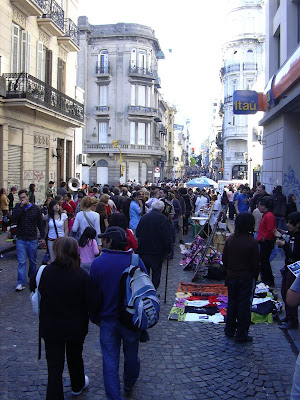The three wineries we visited in the Uco Valley were all huge, new, modern operations funded by foreign investment - in some cases as hobbies by very wealthy individuals simply for ability to say "I own a winery."
The first was Bodegas Andeluna, owned by the same family as the Frito Lay potato-chip empire. Their enormous showcase facility has a one million liter tank capacity, a 1,200 barrel aging capacity, and a 720,000 bottle storage capacity - which we toured after sampling some very nice Malbec at their tasting bar.
Our next stop was at a Clos de los Siete's (Vineyard of the Seven), a collection of seven wineries on a single huge estate, where we enjoyed a rooftop tasting at the Monteviejo Winery which included the 2007 Clos de los Siete (50% Malbec, 30% Cab., 10% Merlot and 10% Syrah), the 2007 Flechas de los Andes Gran Malbec (which seemed surprisingly mild for a young Malbec) and the 2004 Lindaflor Malbec.
Our final stop was at the Bodegas O. Fournier, where workers were still putting some final touches on the new state-of-the-art, gravity-fed wine-making facility.
 Touring these big places was bit overwhelming - it was more like being on a factory tour than a wine tour. We didn't buy any wine at these places because they were all huge operations centered on the export market and we can probably find there stuff at a good wine store back home.
Touring these big places was bit overwhelming - it was more like being on a factory tour than a wine tour. We didn't buy any wine at these places because they were all huge operations centered on the export market and we can probably find there stuff at a good wine store back home.Although we definitely enjoyed visiting the smaller family-run places more than these big industrial operations, we were still glad to be able to see the full range of what's happening in a booming wine region. And everything we tasted was great!
Plus, we got to enjoy yet another gourmet meal that was an experience in itself - four courses paired with seven wines!
APPETIZERS:
MAIN COURSE:
 Mixed Ragu of Veal & Lamb, garnished with polenta with white truffle.
Mixed Ragu of Veal & Lamb, garnished with polenta with white truffle.There was also an option for crispy pasta filled with vegetables on caper sauce.
These were accompanied by several of O. Fournier's "Urban" line of wines, with a choice of their top-line wines to go with the main course. We each ordered a different one, and shared:
2003 B Crux - 60% Tempranillo, 20% Malbec, 10% Merlot and 10% Syrah. Aged 12 months in French oak
2002 Alfa Crux - 60% Tempranillo, 35% Malbec, 5% Merlot. Aged 17 months in new barrels (80% french and 20% American)















































